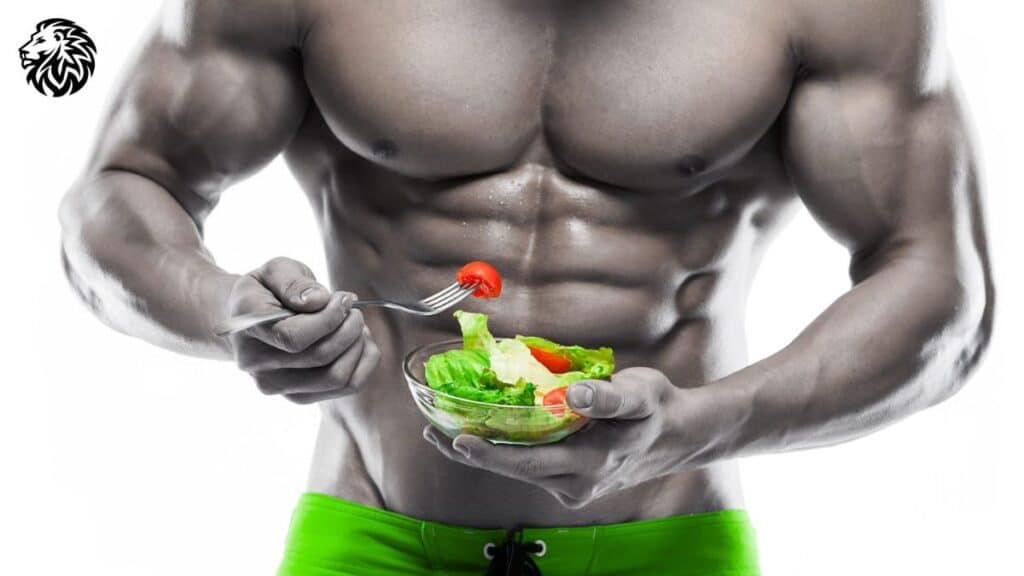Muscle gain and fat loss, often viewed through the lens of exercise routines, pivot crucially around dietary habits as well. The energy and building blocks supplied by the diet enable muscular growth and repair, while the balance between caloric intake and expenditure determines fat loss or gain. Here, the principle that “you cannot out-train a bad diet” holds weight, affirming that a strategic diet is indispensable for sculpting a lean, muscular physique.
Navigating through the myriad of popular dietary approaches like the ketogenic diet, paleo, low-carb, vegan, and intermittent fasting, each claims its own unique set of benefits and challenges concerning muscle gain and fat loss. Some prioritize protein intake, some champion the timing of meals, while others focus on eliminating specific food groups—all in the pursuit of optimal physical transformation.
This article embarks on a journey to dissect and synthesize available scientific insights, thereby unveiling a diet that meticulously balances the dichotomy of muscle gain and fat loss. By navigating through the critical roles of macronutrients and understanding the symbiotic relationship between diet and exercise, we aim to provide a comprehensive guide that fuses evidence-based knowledge with practical application in the quest to sculpt a healthier, muscular, and leaner body.
In the following sections, we will delve deeper into the nutritional intricacies, exploring the respective roles of proteins, carbohydrates, and fats in achieving these seemingly divergent goals, and offering tangible, adaptable strategies for your dietary endeavors.
Understanding Basic Nutritional Needs

Explanation of Macronutrients: Proteins, Carbohydrates, and Fats
The triumvirate of macronutrients—proteins, carbohydrates, and fats—plays a pivotal role in every dietary strategy. Proteins serve as the building blocks for muscles, enzymes, and various physiological structures. Carbohydrates act predominantly as energy suppliers, fueling various bodily functions and activities, while fats, apart from being a dense energy source, are paramount for cellular health and hormonal balance. These macronutrients, in varied ratios, sculpt our dietary intake and, by extension, our physiological progress and health.
The Role of Each Macronutrient in Muscle Building and Fat Loss
- Proteins are indispensable for muscle growth and repair, given their role in providing amino acids—the fundamental building blocks that facilitate the synthesis and repair of muscle tissue, especially post-exercise.
- Carbohydrates provide the necessary energy for workouts and daily activities, and play a role in replenishing glycogen stores within the muscles, which is crucial for recovery and sustained performance.
- Fats are vital for hormonal regulation, including the production of testosterone and growth hormone, which are integral to muscle development and metabolic health. Moreover, fats ensure the absorption of fat-soluble vitamins, supporting overall physiological functionality and health.
The manipulation of these macronutrients in one’s diet has a pronounced impact on the body’s ability to build muscle and/or shed fat, making a nuanced understanding of them fundamental for achieving specific physical goals.
The Concept of Calorie Surplus and Deficit
A fundamental principle in the dialogue of weight management is the concept of caloric surplus and deficit. A caloric surplus, wherein one consumes more calories than expended, is vital for providing the additional energy and nutritional support required for muscle growth. Conversely, a caloric deficit, characterized by expending more calories than consumed, is essential for facilitating fat loss, as the body taps into stored fat to meet its energy requirements. Striking a balance between these two states, or strategically oscillating between them, can support a journey towards a physique that is both muscular and lean. The upcoming sections will delve further into how this balance can be achieved and maintained through meticulous dietary management.
Diets and Muscle Gain

Importance of Protein in Muscle Building
- Biological Role of Protein:
Proteins, comprising amino acids, are integral to muscle building. They facilitate muscle protein synthesis, repair damaged muscle tissues, and support the development of new fibers, especially following resistance training. Without adequate protein, the body’s ability to repair and grow muscle is notably hindered, undermining muscle gain efforts. - Recommended Protein Intake for Muscle Gain:
General guidelines suggest an intake of 1.6 to 2.2 grams of protein per kilogram of body weight for those engaging in resistance training to optimize muscle protein synthesis. However, individual needs may vary based on factors like age, training intensity, and overall health.
Carbohydrates and Energy During Workouts
- How Carbs Function as Energy Sources:
Carbohydrates, broken down into glucose, serve as a primary energy source, fueling workouts and aiding in recovery. They replenish muscle glycogen stores, which are depleted during intensive training, ensuring sustained energy levels and mitigating premature fatigue. - Ideal Carbohydrate Intake for Muscle-Building Workouts:
Carbohydrate needs can typically range from 3-6 grams per kilogram of body weight. Those engaging in high-intensity training may lean towards the higher end to adequately fuel workouts and optimize recovery. Timing and type of carbohydrate (fast or slow-releasing) also warrant consideration.
Healthy Fats and Hormone Production
- Role of Fats in Hormone Regulation, Including Muscle-Building Hormones:
Fats play a pivotal role in the production and regulation of hormones like testosterone and growth hormone, which are essential for muscle development. Adequate fat intake also supports overall metabolic health, energy production, and inflammation control. - Healthy Fat Sources:
Prioritizing sources of healthy fats, such as avocados, nuts, seeds, olive oil, and fatty fish, ensures that fat intake not only supports muscle building but also underpins overall health by providing essential fatty acids and aiding in the absorption of fat-soluble vitamins.
Balancing these macronutrients—ensuring adequate protein for muscle repair, carbohydrates for energy, and fats for hormonal health—forms the bedrock upon which a muscle-gain diet should be built, providing the nutritional milieu conducive to growth and development. Further sections will elaborate on how to adapt these principles for fat loss while preserving muscle mass.
Diets and Fat Loss

Importance of Creating a Calorie Deficit
- Explanation of How a Calorie Deficit Works:
A calorie deficit occurs when the energy expended surpasses the energy consumed. This energy imbalance prompts the body to utilize stored fat as a supplementary energy source, leading to fat loss. Various factors, including basal metabolic rate (BMR), physical activity, and thermic effect of food, contribute to total daily energy expenditure (TDEE), which is pivotal in calculating and implementing a deficit. - Strategies to Create a Sustainable Calorie Deficit:
Implementing a sustainable calorie deficit involves tactics like modestly reducing caloric intake, incrementing physical activity, and selecting foods that optimize satiety (like high-fiber vegetables and lean proteins). A generally accepted approach is aiming for a deficit of 500-1000 calories per day, which should result in a safe and sustainable loss of about 0.5-1 kg per week.
Macronutrient Ratios for Fat Loss
- Lowering Carb Intake and Focusing on Quality Sources:
Reducing carbohydrate intake can assist in creating a calorie deficit. Emphasizing quality sources like whole grains, vegetables, and fruits also ensures nutrient density and sustained energy release, helping manage appetite and maintain energy levels during a caloric deficit. - Ensuring Adequate Protein to Preserve Muscle Mass:
Maintaining a higher protein intake during a calorie deficit is vital to preserving lean muscle mass. Adequate protein can also enhance satiety and slightly elevate metabolic rate due to its higher thermic effect compared to carbohydrates and fats.
Role of Meal Timing and Frequency
- Intermittent Fasting and Its Effects on Fat Loss:
Intermittent fasting (IF), which involves cycling between periods of eating and fasting, has gained attention for its potential in facilitating fat loss while being mindful of muscle preservation, though its efficacy is often context-dependent and may vary among individuals. - Nutrient Timing Around Workouts for Optimal Recovery and Growth:
Nutrient timing, particularly the intake of protein and some carbohydrates around the workout period, can support muscle recovery and growth even in a caloric deficit, ensuring that the muscle tissue is supported and the impact of workouts is maximized.
Navigating through a caloric deficit while maintaining muscle mass necessitates a nuanced approach to diet, where macronutrient quality and timing become focal points of consideration. In the ensuing sections, we will explore the delicate balance and strategic implementation of these principles to concurrently support muscle gain and fat loss.
Balancing Muscle Gain and Fat Loss

Challenge of Achieving Both Goals Simultaneously
Negotiating the dichotomy of muscle gain, which generally requires a caloric surplus, and fat loss, which necessitates a caloric deficit, presents a nuanced challenge. Achieving both simultaneously, often referred to as “body recomposition,” involves a meticulous and often dynamic approach to diet and training to foster an environment conducive to both muscle anabolism and fat catabolism.
Strategies for Optimizing Diet for Both Muscle Gain and Fat Loss
- Cycling Calories and Macronutrients:
Implementing cyclical approaches like calorie and/or macronutrient cycling, where periods of caloric surplus (focused on muscle gain) are interchanged with periods of caloric deficit (focused on fat loss), can be a strategic way to address both goals. This might involve higher calorie and carb intake on training days and a reduced intake on rest or low-activity days. - Prioritizing Protein and Adjusting Other Macronutrients:
Keeping protein intake consistently high is vital to support muscle synthesis, especially during periods of caloric deficit. The remaining caloric intake can be adjusted by modulating carbohydrate and fat intake, depending on whether the focus is on muscle gain or fat loss during a particular period.
Monitoring and Adjusting the Diet
- Keeping a Food Diary and Tracking Progress:
Maintaining a food diary and regularly tracking variables like body weight, muscle circumference, and performance metrics helps gauge the efficacy of the dietary strategy and sheds light on areas that might need adjustment. - Making Necessary Adjustments Based on Results:
Periodic assessment of progress and data, gleaned from consistent tracking, forms the basis for informed adjustments to the diet. This might involve tweaking caloric intake, macronutrient ratios, or even meal timing to ensure continued progress toward muscle gain and fat loss.
Balancing muscle gain and fat loss demands a holistic, adaptable approach that melds scientific principles with individual variability. This careful balancing act, while intricate, can pave the way toward effectively realizing both objectives, crafting a pathway that is both scientifically grounded and pragmatically viable in the pursuit of a lean, muscular physique. Future sections will delve into pragmatic examples and case studies to further illustrate the application of these principles.
Considerations for Different Populations

Gender, Age, and Physiological Differences
Navigating through the varied spectrums of gender, age, and physiological conditions necessitates adjustments in dietary strategies to reflect the specific needs and metabolic considerations of different populations. Men and women may have varied metabolic rates and hormonal profiles, influencing muscle gain and fat loss, while aging populations might contend with aspects like decreased muscle mass (sarcopenia) and metabolic slowdown, requiring tailored approaches.
Adapting the Diet for Different Activity Levels and Goals
Athletes, sedentary individuals, and recreational exercisers each harbor distinct nutritional needs and considerations. Athletes may require higher overall caloric and protein intakes to support intensive training regimens, while sedentary individuals might focus more on nutrient-dense, lower-calorie foods to support health without surplus caloric intake. The intertwining of dietary strategy with activity level and specific performance or physique goals necessitates individualized approaches that encapsulate both energy and nutrient requirements.
Addressing Nutritional Requirements for Various Health Conditions
Individuals navigating through specific health conditions, such as diabetes, cardiovascular diseases, or gastrointestinal issues, require specially curated dietary approaches. Here, considerations might include managing carbohydrate intake for blood sugar control (diabetes) or prioritizing heart-healthy fats (cardiovascular health). Nutritional strategies must, therefore, be carefully scaffolded to support health while concurrently facilitating muscle gain and fat loss in a safe, sustainable manner.
Different populations, with their respective nuances and specificities, warrant a conscientious and individualized approach to dieting for muscle gain and fat loss. By amalgamating foundational scientific principles with tailored modifications, dietary strategies can be optimally configured to support the varied needs and goals of diverse individuals, ensuring both efficacy and safety in the pursuit of physical objectives. Future discussions will illuminate how these tailored approaches can be practically implemented and managed for long-term success.
Practical Tips and Example Meal Plans
Sample Meal Plans for Muscle Gain and Fat Loss
Crafting meal plans that synchronize with the dual objectives of muscle gain and fat loss involves creating nutritiously dense, balanced meals that fulfill both energy and macronutrient requirements. A muscle-gain day might feature higher caloric intake, prioritizing both protein and carbohydrates to support training and recovery, while a fat-loss day could highlight a moderated caloric intake, still prioritizing protein but potentially reducing carbohydrate and/or fat intake to establish a caloric deficit.
- Muscle Gain Day Example:
- Breakfast: Scrambled eggs, whole-grain toast, and a fruit smoothie.
- Lunch: Grilled chicken, quinoa, and a variety of colorful vegetables.
- Snack: Greek yogurt with honey and almonds.
- Dinner: Salmon, sweet potato, and steamed broccoli.
- Fat Loss Day Example:
- Breakfast: Oatmeal topped with sliced banana and a scoop of protein powder.
- Lunch: Lentil soup with a side salad.
- Snack: A handful of mixed nuts.
- Dinner: Grilled shrimp, sautéed spinach, and mixed vegetables.
Tips for Meal Preparation and Ensuring Nutritional Adequacy
Ensuring nutritional adequacy and streamlined meal preparation often revolves around strategic planning and organization.
- Planning: Develop a weekly meal plan, considering varied protein sources, colorful vegetables, and varied carbohydrate and fat sources to ensure nutritional diversity.
- Batch Cooking: Prepare large portions of protein sources, grains, and vegetables that can be utilized across several meals to save time.
- Snack Preparation: Have readily available and portion-controlled snacks, like mixed nuts or chopped vegetables, to manage hunger and avoid impulsive choices.
- Diversification: Ensure a variety of foods across the week to meet micro and macronutrient needs, supporting overall health.
Strategies to Overcome Common Challenges
Navigating through the journey of muscle gain and fat loss is invariably punctuated with challenges that necessitate strategic solutions.
- Hunger Management: Incorporate foods high in fiber and protein to enhance satiety during periods of caloric restriction.
- Consistency: Establish a routine that aligns with daily life, ensuring that meal timing and content are both practical and satisfying.
- Adaptation: Be prepared to modify plans based on physical responses, preferences, and progress, ensuring that the strategy remains dynamic and responsive to ongoing needs and challenges.
Marrying the theoretical with the practical is pivotal to actualize muscle gain and fat loss objectives. These sample meals and practical strategies serve as a scaffold upon which individualized plans can be built, modified, and optimized, supporting both physiological goals and lifestyle integration in a harmonious, sustainable manner. Future explorations will delve into further individualizing and adapting these strategies to facilitate lifelong adherence and continuous progress.
Conclusion
Navigating through the nutritional landscapes pivotal to both muscle gain and fat loss, the interplay between caloric surplus and deficit, macronutrient balance, and strategic meal planning has been explored. The varying and often unique nutritional needs of different populations, from athletes to individuals with specific health conditions, underscored the necessity for tailored, individualized approaches.
Emphasizing the importance of a balanced and sustainable dietary approach, it is essential to eschew extremes in favor of a diet that is nourishing, satisfying, and conducive to long-term adherence. While specific goals may necessitate periods of more structured eating, integrating flexibility and variety ensures that the approach is both nutritionally complete and psychologically satisfying.
Undertaking a journey towards muscle gain and fat loss mandates a commitment to consistency and an understanding that meaningful physiological changes unfold over time. The synergy of scientifically grounded strategies, adaptability, and patient, consistent application paves the way towards achieving and maintaining the sought-after balance of muscle accretion and fat reduction. An approach that entwines practicality with evidence-based principles provides a sturdy, navigable path towards realizing physical objectives while maintaining a nurturing, sustainable relationship with food and nutrition.
In stitching together the multifaceted threads of nutrition, exercise, and lifestyle, the tapestry that emerges is one that sustains and propels forward in a journey that transcends physique, embedding itself into the realms of health, wellbeing, and empowered, informed living.







